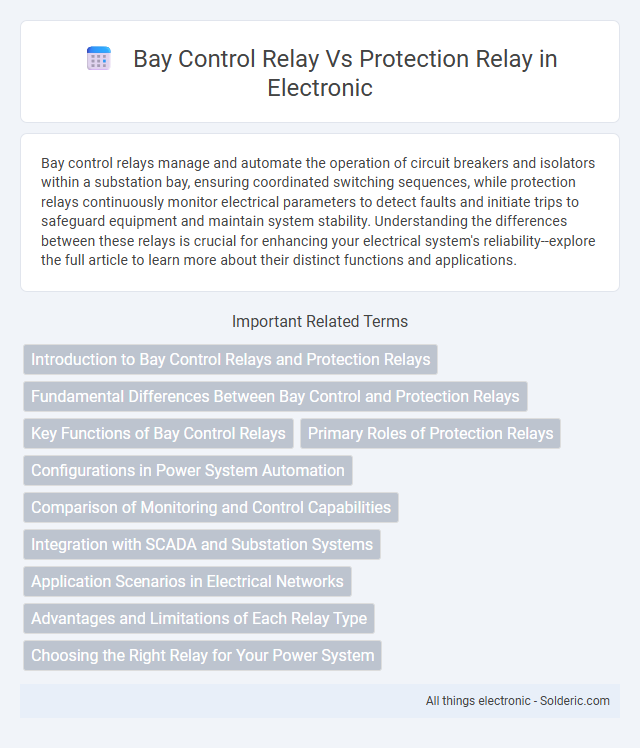Bay control relays manage and automate the operation of circuit breakers and isolators within a substation bay, ensuring coordinated switching sequences, while protection relays continuously monitor electrical parameters to detect faults and initiate trips to safeguard equipment and maintain system stability. Understanding the differences between these relays is crucial for enhancing your electrical system's reliability--explore the full article to learn more about their distinct functions and applications.
Comparison Table
| Aspect | Bay Control Relay | Protection Relay |
|---|---|---|
| Primary Function | Controls and monitors bay equipment like circuit breakers and disconnectors | Detects faults and initiates tripping to protect electrical systems |
| Application | Operational control within substations | Fault detection and system protection |
| Key Features | Switching commands, status indication, interlocking | Overcurrent, earth fault, differential, distance protection |
| Response | Controls equipment operation, slower response | Fast tripping during fault conditions |
| Examples | Breaker Control Relay, Interlocking Relay | Overcurrent Relay, Distance Relay, Differential Relay |
Introduction to Bay Control Relays and Protection Relays
Bay control relays are specialized devices designed to manage and automate the operation of switchgear in substations, ensuring coordinated control of circuit breakers and isolators. Protection relays serve a critical role in electrical systems by detecting faults such as overcurrent, earth faults, and short circuits, and initiating tripping commands to isolate faulty sections to prevent equipment damage and ensure system stability. Both relay types are fundamental components of substation automation, with bay control relays focusing on operational control and protection relays concentrating on system safety and fault mitigation.
Fundamental Differences Between Bay Control and Protection Relays
Bay control relays primarily manage and automate switching operations in substations, ensuring coordinated control of breakers and isolators for smooth system operation. Protection relays detect electrical faults and initiate circuit breaker trips to isolate faulty sections, safeguarding equipment and maintaining system stability. Your understanding of these fundamental differences enhances effective relay selection and system reliability.
Key Functions of Bay Control Relays
Bay control relays primarily perform functions such as circuit breaker control, interlocking, and status indication, ensuring reliable operation within an electrical substation bay. They coordinate the closing and tripping of breakers based on control commands and safeguard against unsafe switching operations. These relays enable efficient communication between protection devices and control systems to maintain system stability and operational integrity.
Primary Roles of Protection Relays
Protection relays primarily safeguard electrical systems by detecting faults such as overloads, short circuits, and equipment failures to prevent damage and ensure system stability. They continuously monitor electrical parameters and initiate circuit breaker operations when abnormal conditions occur, maintaining safety and reliability. Your system's protection relies on these relays to quickly isolate faulty sections and minimize outages.
Configurations in Power System Automation
Bay control relays in power system automation primarily manage control and status functions within specific bay units, enabling local equipment operation such as circuit breakers and disconnectors through predefined control schemes. Protection relays focus on detecting faults and abnormal conditions by monitoring electrical parameters like current, voltage, and frequency to initiate protective tripping and isolate faulty sections. Configurations differ as bay control relays integrate control logic and status monitoring, whereas protection relays emphasize fault detection algorithms and rapid response coordination for system stability.
Comparison of Monitoring and Control Capabilities
Bay control relays primarily focus on local monitoring and control of switchgear and circuit breakers within a specific bay, enabling real-time status tracking and manual or automatic operation. Protection relays, however, specialize in fault detection and automatic tripping to safeguard electrical equipment, equipped with advanced algorithms for precise fault analysis and isolation. While bay control relays provide operational control functions, protection relays offer critical safety mechanisms through continuous monitoring of electrical parameters like current, voltage, and frequency for rapid fault response.
Integration with SCADA and Substation Systems
Bay control relays typically offer seamless integration with SCADA and substation systems, enabling real-time monitoring and remote operation of specific bay equipment for enhanced operational efficiency. Protection relays are designed primarily for fault detection and isolation but also communicate critical status and event data to SCADA systems to support system reliability and rapid response. Your choice should consider the level of interoperability required to optimize control, automation, and fault management within the substation infrastructure.
Application Scenarios in Electrical Networks
Bay control relays are primarily applied in substation automation to manage and monitor switchgear operations, ensuring precise control of circuit breakers and isolators within a specific bay. Protection relays serve a critical role in safeguarding electrical networks by detecting faults such as overloads, short circuits, or ground faults and initiating fault isolation to prevent equipment damage and system instability. Your choice between bay control and protection relays depends on whether the focus is on operational control within a controlled bay or on system-wide fault detection and response.
Advantages and Limitations of Each Relay Type
Bay control relays provide precise local control and monitoring of electrical equipment within a substation bay, enhancing operational efficiency and reducing response times during switching operations. Protection relays excel in fault detection and isolation, offering rapid response to abnormal conditions that safeguard equipment and maintain system stability. Your selection should balance the bay control relay's intuitive operational advantages with the protection relay's critical safety capabilities to optimize overall system reliability.
Choosing the Right Relay for Your Power System
Selecting the right relay for your power system involves understanding the distinct functions of bay control relays and protection relays. Bay control relays primarily manage and automate control operations within substations, ensuring efficient switching and operational coordination, while protection relays focus on detecting faults and initiating trip signals to safeguard equipment and maintain system stability. Prioritizing protection relays is crucial for fault detection and system safety, whereas bay control relays optimize control and monitoring tasks, making their combined deployment essential for comprehensive power system reliability.
bay control relay vs protection relay Infographic

 solderic.com
solderic.com